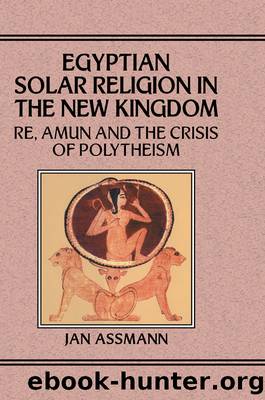Egyptian Solar Religion by Assmann

Author:Assmann
Language: eng
Format: epub
Publisher: Taylor and Francis
I corresponds to the first hymn of Antef. The text was also known elsewhere in Thebes, cf. STG text no.s 74 and 180c (in TT 57 and 192 respectively: Amenophis III). The peculiar feature of this hymn is the reference to the solar journey in both nominal and verbal form: the eulogy refers to the solar cycle as a whole (prj/ḥtp), the verbal form (vv.4-5) only to the phase of âpassageâ.102 In this the text follows a rule that is frequently observed.103
III = text LL 111,1 w.3-6.
II is a eulogy inserted between these two traditional texts and is closely connected with our texts. Here too the subjects are primevality, uniqueness and selfcreation, but in phraseologically different forms of expression. The subjects âruleâ, âcreationâ and âbenefactorâ are missing. The solar aspect is expressed in w.10-11, again using different phraseology. The relationship to Maat, emphasised in v.7, also plays a striking role in STG no. 165 (w. 14-15).104
The strong emphasis on the benefactor-preserver aspect of the divine nature might be peculiar to Theban Amun-Re theology, as it occurs in the eulogies of the early phase of the New Kingdom. The text of Antef (STG no. 165), in the two hymns which it associates with I, develops exclusively this benefactor-preserver aspect, which is missing from the Copenhagen text. II explains in the first three verses the adjective mctj, which corresponds to the nb Mct of the Copenhagen text (v.7), here as there in connection with the uniqueness (jwtj snnw=f). The last two verses interpret the solar movement as an intentional act of the god aimed at preserving his creation:
pḫrw twj m grḥ mj hrww The one who crosses the Two Lands night and day
r scnḫ prt m jrt=f to keep alive what came forth from his eye.
Here we have an extremely concise expression of an anthropocentric cosmology, which makes the solar journey take place for the benefit of human beings, since they are the ones who, according to a widespread biogonic myth, have come forth âfrom the eyeâ of the creator god.105
The earliest and most explicit statement of this anthropocentric interpretation of the solar journey occurs in the well known closing hymn of the Teaching for Merikare:
ḥnw rmṯw cwt nt nṯr Humans, the livestock of god, are well cared for
jr.n=f pt t n jb=sn he made heaven and earth for their sake
dr.n=f snk n mw he pushed the greediness of the waters back
jr.n=f ṯ3w n-jb cnḫ fná¸w=sn and created the air so that their nostrils might live.
snnw=f pw prjw m ḥcw=f His images are those that have come forth from his body
wbn=f m pt n-jb=sn For their sake he rises to heaven
jr.n=f n=sn smwcwt it is for them that he has made plants and animais
pdw rmw <r> snm.st birds and fish to nourish them.
sm.n=f ḫftjw=f hd.n=f msw=f He killed his enemies and went against his children
ḥr kt=sn jrt sbj because they thought of rebellion.
jrr=f sšp n jb=sn For their sake he causes there to be light.
sqdd=f r m st To see them he travels (the heavens).
Download
This site does not store any files on its server. We only index and link to content provided by other sites. Please contact the content providers to delete copyright contents if any and email us, we'll remove relevant links or contents immediately.
Phoenicians among Others: Why Migrants Mattered in the Ancient Mediterranean by Denise Demetriou(583)
Verus Israel: Study of the Relations Between Christians and Jews in the Roman Empire, AD 135-425 by Marcel Simon(580)
Caesar Rules: The Emperor in the Changing Roman World (c. 50 BC â AD 565) by Olivier Hekster(564)
american english file 1 student book 3rd edition by Unknown(546)
Europe, Strategy and Armed Forces by Sven Biscop Jo Coelmont(509)
Basic japanese A grammar and workbook by Unknown(508)
Banned in the U.S.A. : A Reference Guide to Book Censorship in Schools and Public Libraries by Herbert N. Foerstel(474)
Give Me Liberty, Seventh Edition by Foner Eric & DuVal Kathleen & McGirr Lisa(472)
The Roman World 44 BC-AD 180 by Martin Goodman(465)
Reading Colonial Japan by Mason Michele;Lee Helen;(461)
DS001-THE MAN OF BRONZE by J.R.A(455)
The Dangerous Life and Ideas of Diogenes the Cynic by Jean-Manuel Roubineau(445)
Introducing Christian Ethics by Samuel Wells and Ben Quash with Rebekah Eklund(443)
Imperial Rome AD 193 - 284 by Ando Clifford(436)
The Oxford History of World War II by Richard Overy(436)
Literary Mathematics by Michael Gavin;(400)
Catiline by Henrik Ibsen--Delphi Classics (Illustrated) by Henrik Ibsen(395)
Language Hacking Mandarin by Benny Lewis & Dr. Licheng Gu(391)
How to Reach the 9.0 in IELTS Academic Reading by IELTS Medical(364)
